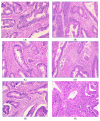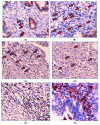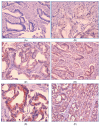The Potential of PD-1 and PD-L1 as Prognostic and Predictive Biomarkers in Colorectal Adenocarcinoma Based on TILs Grading
- PMID: 39727675
- PMCID: PMC11674277
- DOI: 10.3390/curroncol31120552
The Potential of PD-1 and PD-L1 as Prognostic and Predictive Biomarkers in Colorectal Adenocarcinoma Based on TILs Grading
Abstract
Aim: Colorectal cancer (CRC) is a prevalent malignancy with a high mortality rate. Tumor-infiltrating lymphocytes (TILs) play a crucial role in the immune response against tumors. Programmed death-1 (PD-1) and programmed death-ligand 1 (PD-L1) are key immune checkpoints regulating T cells in the tumor microenvironment. This study aimed to assess the relationships among PD-1 expression on TILs, PD-L1 expression in tumors, and TIL grading in colorectal adenocarcinoma.
Methods: A cross-sectional design was employed to analyze 130 colorectal adenocarcinoma samples. The expression of PD-1 and PD-L1 was assessed through immunohistochemistry. A semi-quantitative scoring system was applied. Statistical analysis with the chi-square test was performed to explore correlations, with the data analyzed in SPSS version 27.
Results: PD-1 expression on TILs significantly correlated with a higher TIL grading (p < 0.001), while PD-L1 expression in tumors showed an inverse correlation with TIL grading (p < 0.001).
Conclusions: The expression of PD-1 on TILs and PD-L1 on tumor cells correlated significantly with the grading of TILs in colorectal adenocarcinoma. This finding shows potential as a predictive biomarker for PD-1/PD-L1 blockade therapy. Further studies are needed to strengthen these results.
Keywords: PD-1; PD-L1; biomarkers; colorectal cancer; immunotherapy; tumor infiltrating lymphocytes.
Conflict of interest statement
The authors declare no competing interests. The funders were not involved in the design of the study, data collection, analysis, or interpretation, nor in the writing of the manuscript or the decision to publish the findings.
Figures



Similar articles
-
Programmed death-ligand 1 expression and tumor-infiltrating lymphocytes in colorectal adenocarcinoma.Minerva Med. 2020 Aug;111(4):337-343. doi: 10.23736/S0026-4806.20.06401-0. Minerva Med. 2020. PMID: 33032394
-
Immune classification for the PD-L1 expression and tumour-infiltrating lymphocytes in colorectal adenocarcinoma.BMC Cancer. 2020 Jan 28;20(1):58. doi: 10.1186/s12885-020-6553-9. BMC Cancer. 2020. PMID: 31992245 Free PMC article.
-
Prognostic impact of programed cell death-1 (PD-1) and PD-ligand 1 (PD-L1) expression in cancer cells and tumor infiltrating lymphocytes in colorectal cancer.Mol Cancer. 2016 Aug 24;15(1):55. doi: 10.1186/s12943-016-0539-x. Mol Cancer. 2016. PMID: 27552968 Free PMC article.
-
LAG-3 Protein Expression in Non-Small Cell Lung Cancer and Its Relationship with PD-1/PD-L1 and Tumor-Infiltrating Lymphocytes.J Thorac Oncol. 2017 May;12(5):814-823. doi: 10.1016/j.jtho.2017.01.019. Epub 2017 Jan 26. J Thorac Oncol. 2017. PMID: 28132868
-
The tale of TILs in breast cancer: A report from The International Immuno-Oncology Biomarker Working Group.NPJ Breast Cancer. 2021 Dec 1;7(1):150. doi: 10.1038/s41523-021-00346-1. NPJ Breast Cancer. 2021. PMID: 34853355 Free PMC article. Review.
References
-
- Nagtegaal I.D., Odze R.D., Klimstra D., Paradis V., Rugge M., Schirmacher P., Washington K.M., Carneiro F., Cree I.A., the WHO Classification of Tumours Editorial Board The 2019 WHO classification of tumours of the digestive system. Histopathology. 2020;76:182–188. doi: 10.1111/his.13975. - DOI - PMC - PubMed
-
- Kumar V., Abbas A.K., Aster J.C., Deyrup A.T. Robbins & Kumar Basic Pathology. 11th ed. Elsevier; Amsterdam, The Netherlands: 2022.
MeSH terms
Substances
LinkOut - more resources
Full Text Sources
Medical
Research Materials

